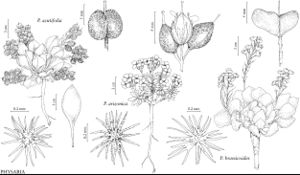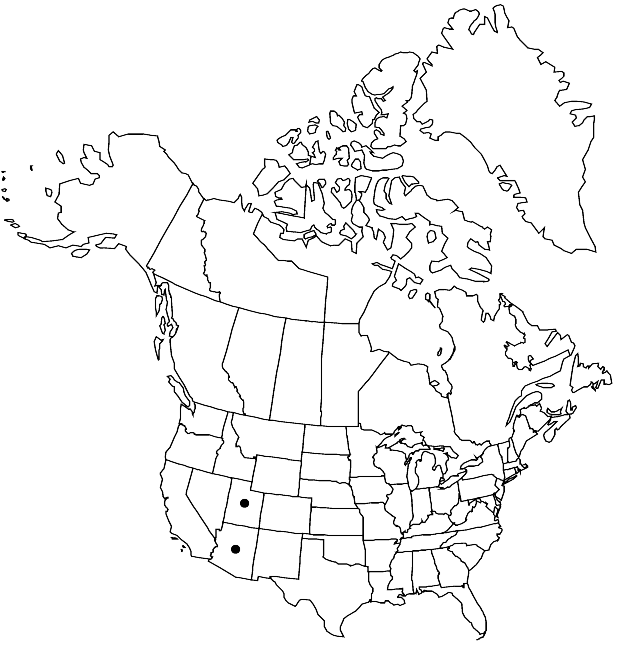Physaria arizonica
Novon 12: 321. 2002.
Perennials; caudex branched, (cespitose); densely (silvery gray) pubescent, trichomes (sessile or subsessile), (4-), 6-, or 8-rayed, rays fused at base, furcate or bifurcate, (slightly umbonate, tuberculate throughout). Stems simple or few to several from base, erect, (unbranched, slender), 0.2–1(–1.5) dm. Basal leaves (densely tufted, not rosulate, reflexed in age); blade obovate to oblanceolate, 0.7–2(–3) cm, margins usually entire, sometimes repand or shallowly dentate, (apex acute). Cauline leaves similar to basal, becoming narrower distally, somewhat reflexed, (distal) blade linear or narrowly oblanceolate, 0.5–2.5(–5.5) cm. Racemes dense, often subcorymbiform. Fruiting pedicels (erect or divaricate-spreading, straight or slightly curved), (3–)5–10(–15) mm. Flowers: sepals (green or greenish yellow), ovate or broadly ovate, 3.5–6.5 mm, (lateral pair subsaccate, cucullate, median pair thickened, slightly cucullate apically); petals (spreading), oblanceolate to obovate, 5.5–8(–10) mm, (claw erect). Fruits (sessile or substipitate), suborbicular to ovoid or ellipsoid, slightly inflated, 4–7 mm; valves pubescent outside, trichomes substipitate, spreading, sometimes sparsely pubescent inside, trichomes sessile, smooth; ovules 4–10(–16) per ovary; style (0.5–)1–2(–4) mm (shorter than fruit). Seeds flattened. 2n = 10.
Phenology: Flowering Apr–Jun.
Habitat: Sandy and gravelly soils, limey knolls or limestone chip, often in open stands of sagebrush-pinyon, pinyon-juniper, Gambel oak and sometimes ponderosa pine
Elevation: 1000-2200 m
Discussion
The circumscription of Physaria arizonica here is quite broad and includes plants that have densely tufted basal leaves and relatively few or no cauline leaves; plants that are loosely tufted and have several cauline leaves; and plants that have a strongly branched caudex, leafy stems, and sterile shoots (var. andrusensis). Additional study is needed to understand the pattern of variation in this complex species; all of the characters given above vary considerably.
Selected References
None.

